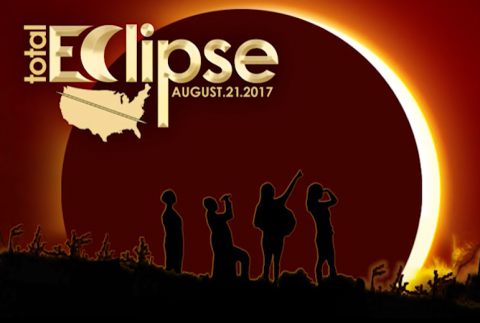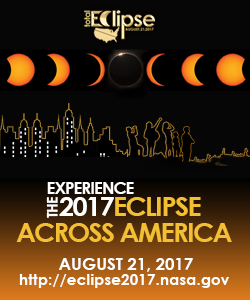
Looking for information about the 2023 and 2024 solar eclipses?
please visit https://www.nisenet.org/solareclipse
2017 Total Solar Eclipse Who? What? Where? When? and How?
Who Can See It
Lots of people! Everyone in the contiguous United States, in fact, everyone in North America plus parts of South America, Africa, and Europe will see at least a partial solar eclipse, while the thin path of totality will pass through portions of 12 states.
What is It?
This celestial event is a solar eclipse in which the moon passes between the sun and Earth and blocks all or part of the sun for up to an hour and a half, from beginning to end, as viewed from a given location. For this eclipse the longest period when the moon completely blocks the sun will be about two minutes and 40 seconds. The last time the contiguous U.S. saw a total eclipse was in 1979.
Where Can You See It?
You can see a partial eclipse, where the moon covers only a part of the sun, anywhere in North America (see "Who can see it?"). To see a total eclipse, where the moon fully covers the sun for a short few minutes, you must be in the path of totality. The path of totality is a relatively thin ribbon, around 70 miles wide, that will cross the U.S. from West to East. The first point of contact will be at Salem, Oregon at 17:17 UTC. Over the next hour and a half, it will cross through Oregon, Idaho, Wyoming, Nebraska, Kansas, Missouri, Illinois, Kentucky, Tennessee, Georgia, and North and South Carolina. It will leave the U.S. near Charleston, South Carolina where maximum totality will occur at 6:47 UTC. Its longest duration will be at Carbondale, Illinois.
When Can You See It?
Times for partial and total phases of the eclipse vary depending on your location. This interactive eclipse map will show you times for the partial and total eclipse anywhere in the world.
How Can You See It?
You never want to look directly at the sun without appropriate protection except during totality. That could severely hurt your eyes. However, there are numerous safe ways to view an eclipse. Click here for eclipse viewing techniques and safety.
Learn more
Planning and Preparing for Your Solar Eclipse Event
- NISE Network planning resources
- Pages 13-16 of Explore Science: Earth & Space 2017 Event Planning and Promotion Guide
- NISE Net Online Workshop: Tips for Planning Your August 21, 2017 Solar Eclipse Event (Recorded January 27, 2017)
-
NISE Net Online Workshop: Streaming the Eclipse: How to Utilize Online Live Streams at Your Eclipse Event (Recorded June 20, 2017)
-
NISE Net Online Workshop: Join the Eclipse Party! What are You Doing to Celebrate the August 21st, 2017 Total Solar Eclipse? (Recorded Tuesday, June 27, 2017)
- NISE Net PowerPoint presentation: Preparing for a Partial Eclipse: An Event to Remember slides (with presenter notes)
- NASA event planning resources
- Maps and visualizations
- Enter your Zip code to find your peak viewing time: Using NASA data, Vox created a zip code tool to find out what you’ll see, and the time you’ll see it, in your zip code.
- NASA solar eclipse maps
- NASA events map - we encourage NISE Network partners to please submit your event to be featured on NASA's general event eclipse map!
- NASA Solar Eclipse 2017 visualizations
- NASA Eyes solar eclipse 3D simulation
- More event planning resources
- Astronomers Without Borders (AWB) Eclipse Project resources AWBeclipse2017.org
- Exploratorium series of videos on safe viewing and eclipse science
- Astronomical Society of the Pacific eclipse resources
- NSTA Solar Science Insert
- Video from University of Colorado Fiske Planetarium Preparing for the Great American Eclipse August 21,2017 (suitable for public audiences)
- 2017 Total Eclipse Resources on NASA Wavelength
- STAR_Net participating libraries and STAR_Net Eclipse Guide
Hands-on Activities During Your Event
- NISE Network Explore Science: Earth & Space 2017 toolkit
- Big Sun, Small Moon activity (included in Explore Science: Earth & Space 2017 toolkit)
- Includes Solar Eclipse poster and solar eclipse pinhole postcards (see video of how to use the pinhole projector)
- Solar Eclipse activity (included in Explore Science: Earth & Space 2017 toolkit)
- Includes solar eclipse poster and solar eclipse pinhole postcard
- Bear's Shadow activity (included in Explore Science: Earth & Space 2017 toolkit)
- Pinhole projectors in NSTA Solar Science Insert by Dennis Schatz and Andrew Fraknoi and How to make a pinhole projector NASA video
- More activities from NSTA Solar Science: Exploring Sunspots, Seasons, Eclipses, and More book by Dennis Schatz and Andrew Fraknoi
- More NASA activities from https://eclipse2017.nasa.gov/activities
Finding Experts to Volunteer at Your Event
We encourage you to seek out local experts for your public events. Many astronomy enthusiasts plan to travel to the path of totality, but many will be staying closer to home, so please check out all of these different resources to find experts near you:
- Finding astronomy volunteers - summary and link to recorded online workshop
-
Solar System Ambassadors - NASA trained volunteers located throughout the US
- NASA Subject Matter Experts solar eclipse map - NASA is compiling a list of local experts willing to volunteer just for this event: https://eclipse2017.nasa.gov/sites/default/files/2017_solar_eclipse_SME_s_map.html
Submit Your Event to NASA’s Eclipse Website General Event Map
Help promote your event by submitting your details to the NASA eclipse general event map
Affordable Eclipse Glasses
An eclipse is a rare and striking phenomenon you won't want to miss, but you must carefully follow safety procedures. It is vital that you protect your eyes at all times. The only safe way to look directly at the uneclipsed or partially eclipsed Sun is through special-purpose solar filters, such as eclipse glasses or handheld solar viewers. Homemade filters or ordinary sunglasses, even very dark ones, are NOT safe for looking at the Sun. To date, only three manufacturers have certified that their eclipse glasses and hand-held solar viewers meet the standards for such products.
Sources for eclipse glasses
- Rainbow Symphony
- American Paper Optics
- Thousand Oaks Optical
- EclipseGlasses.com (educator discount)
If you don't have glasses there are other ways to see the eclipse safely:
Enter your Zip code to find your peak viewing time
Using NASA data, Vox created a zip code tool to find out what you’ll see, and the time you’ll see it, in your zip code.
Live Streaming of the Solar Eclipse
The Exploratorium will be live streaming the solar eclipse in multiple formats including on mobile devices, including:
- Exploratorium live stream: https://www.exploratorium.edu/eclipse
- Exploratorium live stream solar eclipse app: https://www.exploratorium.edu/explore/apps/total-solar-eclipse-app
- NASA MegaCast broadcast coverage: https://eclipse2017.nasa.gov/eclipse-live-stream
- NISE Net Online Workshop: Streaming the Eclipse: How to Utilize Online Live Streams at Your Eclipse Event (Recorded June 20, 2017)
Citizen Science Projects
The 2017 solar eclipse presents many opportunities for amateur astronomers and lifelong learners to get in on the fun of doing science. This includes research projects about the sun, the moon, other sun-planet-moon systems, and even eclipses in other stellar systems.
-
What happens to your pets and other animals during the solar eclipse?
-
Naturalist - Life Responds https://www.calacademy.org/citizen-science/solar-eclipse-2017
-
-
How does the solar eclipse affect the atmosphere on Earth? Participate in a nation-wide science experiment by collecting cloud and temperature data
-
GLOBE Observer Video: https://svs.gsfc.nasa.gov/12653
-
GLOBE Observer Program: https://www.globe.gov/web/eclipse/overview
-
GLOBE Observer Observer: https://observer.globe.gov/science-connections/eclipse2017
-
- Many more citizen science projects
In addition to the examples highlighted above, a complete list is available here:




